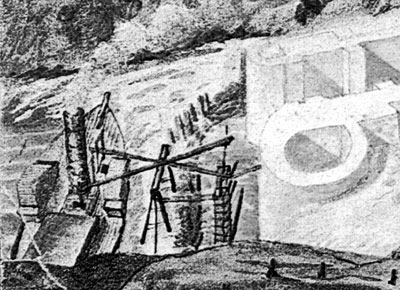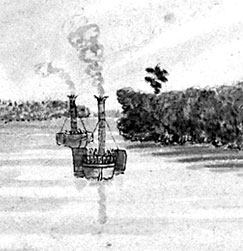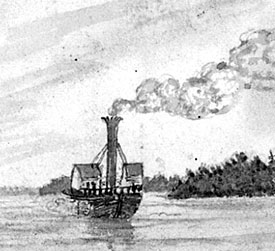The First Steamboat Trip
by
Ken W. Watson
Note: This article first appeared in the Fall 2013 edition of Rideau Reflections, the newsletter of the Friends of the Rideau (www.rideaufriends.com).
 |
The Pumper at Kingston Mills
The only known image of the Rideau/Pumper shows it working at Kingston Mills. Only the front half is visible. The 12 hp steam engine on the ship is being used to power a water pumping mechanism.
A portion of a watercolour painting: “Kingston Mills: Masonry of three lower locks completed, Steamboat "Pumper" at lock entrance”, by Thomas Burrowes, c.1830. Archives of Ontario, C 1-0-0-0-72.
|
We’ve just completed the 182nd year of continuous operation of the Rideau Canal. The Rideau Canal is a UNESCO World Heritage Site in part because of that fact – boats travelling along it today represent a heritage that goes back to when the first full steamboat transit of the canal was made in the spring of 1832. History attributes that honour to Robert Drummond’s paddle wheeler, the Rideau, aka the Pumper. We’ll take a brief look at that trip and the boat that did it.
If Colonel By’s original recommendation for a larger lock size had been accepted, a different boat, one named the John By, would have had the honour of making the first full transit of the canal. By’s initial recommendation was for the locks to be 150 feet long with a minimum navigation depth in the channel of 10 feet. His bosses in Ordnance wouldn’t go for that and he was quickly forced to revise his request to the original Ordnance plan of a minimum 5 foot navigation depth.
In 1831, Robert Drummond, together with a few other shareholders, had the John By purpose-built for the Rideau Canal – it was 110 feet long by 33 feet wide, to just fit into a Rideau lock. It sported a 75 hp low-pressure steam engine and was intended to draught only 3.5 feet. At the time, ship building was mostly an empirical science, and the actual draught of a ship wasn’t known until it hit the water. When the John By was launched, its draught was more that 6 feet, so it couldn’t be used on the Rideau Canal.
It was now the spring of 1832, and work on the southern locks was essentially complete. The northern locks had been completed the previous fall, the steam boat Union (built in Hawkesbury in 1822) having already made trips as far south as Smiths Falls by November, 1831. But By wanted to celebrate the completion of his triumphant first trip by steamboat in Bytown and that meant starting from Kingston using a ship in that location. Although Drummond intended the John By to be that ship, he had a second steamboat available, one already on the Rideau Canal.
That second vessel was his steamboat Rideau, nicknamed Pumper for how it was being used. The 80 foot long by 15 foot wide paddle-wheeler with its 12 hp steam engine was launched, as the Rideau, in Kingston, on June 6, 1829. Shortly after that it was pressed into service at Kingston Mills, to pump out water from behind the coffer dam protecting the lower lock. The only image we have of the Rideau/Pumper is a c.1830 painting showing it being used in this capacity. It is identified in the painting as the Pumper.
Drummond had the Rideau/Pumper spruced up for the inaugural trip along the Rideau Canal, including fitting it up for passengers which were to include Colonel By’s wife Esther and their children, 13-year old Esther and 11-year old Harriet. It was a bit of rush to get the Rideau/Pumper ready, as one observer wrote “It is true the boat, not being intended to ply so soon, if at all, the machinery was a good deal out of order ...”
On May 22, 1832 the trip started with several vessels heading from the Kingston harbour to Kingston Mills. They were led by the dockyard cutter Snake (or Rattlesnake) and two barges, one containing the band of the 66th Regiment. They arrived at Kingston Mills at 1 pm and were locked through. The Rideau/Pumper arrived 3 hours later, to quote from the Upper Canada Herald:
“Precisely at four o’clock, the Steam-Boat Rideau, having on board Colonel By and his family, and several ladies and gentlemen of Kingston, arrived at the first Lock and passed through the whole number in fifty minutes exactly. Three cheers for the Rideau Canal, and the same for Colonel By, Captain Briscoe and Mr. Drummond, respectively being given, the Steam-Boat proceeded on her passage, and the spectators returned to Kingston highly delighted with their excursion.”
The Snake only went as far as Jones Falls and then returned to Kingston with the barges and band.
We have little in the way of first hand accounts of the trip, but Hugh Macgregor, who travelled with Colonel By from Kingston to Narrows wrote:
“It was with great pleasure that on passing through Indian Lake, after leaving Chaffey's Mills, we beheld a party of Indians drawn up rank and file on the beach in front of their encampment, having two Chiefs, and Union flags floating among the dark green foliage of the clustering pines. On our approach, they saluted the boat with a feu de joie in most regular order, and in a style that would not discredit a regularly organized corps. We immediately returned the compliment by firing a cannon several times and making a sheer out of the direct course, passed in front of the encampment, when Col. By received them on board to the number of about 40 men, women and children, who went on to the Isthmus with us, their boats and canoes towed astern of the steamer, ten in number - here we were again received with shouts of applause, from a numerous body of people, ready on the rock to receive us, Captain Cole and lady of the number, several firing guns, which we returned by firing the cannon, and a feu de joie, fired by the Indians who stationed themselves on the wings of the boat.”
At 6 am on May 25, 1832, the Rideau/Pumper arrived in Smiths Falls. The locals were enthusiastic to the point of firing a large 18 pound cannon in salute to Colonel By. That lasted until they loaded the cannon with 10 pounds of gunpowder, tamped some sod into the barrel and lit the fuse. The cannon blew up, parts of the barrel travelling up to 425 feet away (no one was injured).
On May 29, 1832, the Rideau/Pumper arrived in Ottawa. But that wasn’t the actual public opening of the Rideau Canal. Just a couple of days after travelling through Upper Brewers, a mill dam broke on Loughborough Lake (near today’s Battersea), the resulting flood water taking out a coffer dam at Upper Brewers. In addition, Colonel By noted that some of the iron work had broken on some of the locks and in a letter dated May 30, 1832 stated that he hoped the canal would be open to the public in 18 to 20 days.
The Rideau/Pumper is credited with the first commercial trip along the entire line of the Rideau Canal when it left Kingston for Bytown on July 12, 1832 carrying 200 barrels of flour, 60 barrels of pork and an unknown number of passengers.
What happened to the Rideau/Pumper?
We know that the Rideau and Pumper are the same vessel and that it was the first steamboat to make a full transit of the Rideau Canal, in May of 1832. The question then comes up, what happened to it? This is where it gets a bit confusing.
Some researchers have conclude there were two vessels in 1832 named Rideau. That’s because some newspaper articles referred to Drummond’s “new boat, the Rideau” either being built and/or receiving a engine in Merrickville in 1832. So, taking newspaper reports at face value, and if you weren’t aware that the Pumper and Rideau were the same vessel, one conclusion is that Drummond had a new ship built in 1832, exactly the same length, with a wider width, and with the same name as one he already had. That’s an unlikely scenario. Much more likely is that Drummond had the Rideau/Pumper widened for the commercial cargo and passenger trade and fitted with a new engine in 1832. We know that in 1833 it was made 15 feet longer, presumably to be able to carry even more cargo and passengers.
Up until 1840, we see mentions of a steamboat called the Rideau, including a reference to a boiler explosion that killed 2 men in 1838. These mentions are likely the Rideau/Pumper. One source has the boiler explosion being the end of the Rideau in 1838, but another has that in 1841, with its service life as a steamboat over, it was rebuilt as a barge.
The John By had a short service life on Lake Ontario and the St. Lawrence. It was wrecked near Port Credit in October 1833.
The Union, poorly designed (“not noted for obeying her helm”) and laid up from 1829 to 1831, was used on the Rideau Canal for less than 3 years. It was retired from service in 1833.
-Ken Watson
 |
 |
| Rideau/Pumper?
Is one of these steamboats, in portions of two paintings by Thomas Burrowes, two near Beckett’s Landing c.1835 (left) and one near Oliver’s Ferry in 1834 (right), the Rideau/Pumper?
|
|